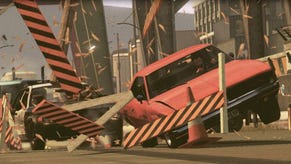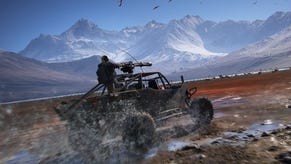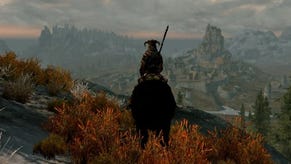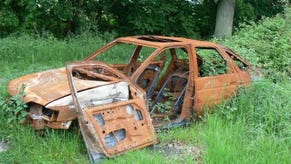Wot I Think - Driver: San Francisco
5 is the magic number
I've spent the last few days behind the wheel of the delayed PC version of Reflections' rebooted car chase game Driver: San Francisco, sinking myself into its open-world singleplayer. I hope to look at multiplayer, which I hear good things about, soon, but meantime here's what I think of John Tanner's latest tale of planes, trains automobiles, automobiles and automobiles.
Driver: San Francisco is so good, to the point that it entirely transcends the PC version being a fairly ropey port. It was impossible not to go into the fifth of Reflection's car-chase series without cynical expectations, given just how badly the franchise got mangled - but now I'm earnestly worried that the poison hangover of Driver 3 is going to keep people away from the best time I've had in a pretend car for a good few years. I thought Trackmania 2 would be the zenith of pixel-based vehicular silliness in 2011, but turns out Driver is a slicker, wilder, more varied and far, far funnier experience even though it doesn't have any mile-high, rock-carved loop-the-loops in the middle of the desert. It just has sharp-talking guys in cars.
DSF is tight and confident, it's written by people with a sharp sense of humour and with a wry eye for the inherent absurdities of video gaming and it finds an easy blend of story-based progression and open-world mucking about. It's too weird, I fear, to be a bona fide smash hit - but it's got quiet cult success written all over it.
First, the crappy news. As was already painfully obvious from the delayed PC release date and the contradictory official claims as to its copy protection, the PC port - and port it most definitely is - appears to be the black sheep of the Driver 5 family. Graphical options are bare-bones basic, so you'll need to fiddle with your card's driver settings to eke the plain-looking best out of the game, while the industry-standard 16:10 widescreen monitor aspect ratio is not supported. On my 1920x1200 screen, I had a choice of black bars top and bottom or the game's 1900x1080 image stretched blurrily into the black space. I speak from the relatively ignorant position of armchair developer here, but it seems very hard to believe that increasing the available resolutions and, if necessary, adjusting interface placement, is anything other than a very easy task. It seems straight-up shameful to leave it out, and so blatant that this game was really only designed for a console and its constant companion, the 16:9 TV.
The net result on a high-res PC screen is a bland and outdated-looking game, and which doesn't feel as fast as it perhaps should - my weak jaw dropped in disbelief when the in-game speedometer told me I was pelting down Russian Hill at over 100MPH, because it felt more like 50. I've not measured the framerate, because BORING, but if there's some sort of limiter in there I'm sure someone will reveal it very soon.
There's no sense that love has gone into Driver 5 on PC, just a game that's been uncaringly dragged over to a platform it doesn't care about, but an outright mess it isn't - it runs smoothly enough, the controls play nice with mouse and keyboard and without troubling you with Xbox prompts (though I confess I enjoy it more when played with a gamepad) and all the online elements such as leaderboards and video-sharing are all present and correct.
Fortunately, there is plenty of love in the game itself, and so much so that I very quickly stopped caring about the slapdash porting. After an initially rote, macho introduction, it swiftly appears to become absolutely delighted about what it can do. In some respects, it's back to Driver basics - all you do is drive, and you have an enormous American city to do it in. There's no on-foot stuff, no shooting, no mini-games that don't involve being in a fast-moving vehicle. But what it really isn't is a racing game; it's worked on finding as many ways to turn the act and concept of driving into an action experience as it can. There's an element of Burnout in there, but without the creepy lifelessness of the machine-only world or the emphasis on massacre-grade levels of destruction. Stuff smashes, and smashes constantly, but it's to add to the car chase feel of the whole affair rather than to present challenge or obstacle itself.
The much-declared philosophy behind it is movie-style chases, with both the cars' handling and San Francisco itself apparently designed to evoke this as much as possible. Cars in Driver 5 aren't keen on cornering, because smoothly cornering just isn't as thrilling as squealing around it dramatically, the car all but out of control and twitching like a mad horse that's been snorting Red Bull as you feverishly fight to steer it back onto the straight and narrow. No simple act of under or oversteering will have the bucking beast doing what you want as soon as you come out of the corner - it'll keep on protesting for a few seconds yet. Sometimes this is infuriating, leading to a monstrous pinballing from wall to oncoming traffic and back and around and back again, but most of the time it gets across what it's supposed to - that you, the mighty and peerless Driver, are superhumanly making this crude machine do more than it was ever supposed to, far more than any other man, woman or Knight 2000 microprocessor could possibly coax from it.
Key to the whole show is that nothing should be taken entirely seriously, no-one is in mortal danger (it's impossible to run over anyone - instead they'll dive out of the way at the last microsecond and look horrified. You could argue this is a cheat but again I think it gets across the look and feel of the heroic movie cop on a desperate chase - a) he's too good a driver to kill anyone and b) having to face the horror of committing manslaughter would quite simply interrupt the flow and tone of this Hollywood logic) and it's possible to recover from even the most spectacular disasters.
In most any other racing game, this would lead to a chorus of dissent from unsmiling greyfaces about the lack of realism or simulation. Fortunately, Driver 5 has a clever get-out clause to avoid this, and it's an idea that goes on to lend far more life and cheer to the game than you might ever have expected.
You might have heard about the Shift mechanic already. As a gaming system, it's great - you can jump to any car in the city and assume immediate control, via an overhead map you can across. As a justification, it works brilliantly. You, as hero cop and automobile fetishist John Tanner, have suffered a rather nasty accident in the line of duty. You're lying in a hospital bed, comatose - but in your mind, you're this disembodied entity able to choose whatever host body you want, so long as it's in a car. It's Quantum Leap meets Deadman, with more than a touch of Life On Mars, but the mystery element of what's really going on is almost totally academic. What's important is that the game declares it is essentially one man's fantasy up front, which means whatever it decides to do is absolutely inarguable. Moreover, that one man believes he is the greatest wheelman in history, so the fantasy panders to that and builds its rules around it. See that speeding getaway vehicle? The cops could never catch it. But Tanner could. See those two young teens who've bet their life savings on being able to win an underground street race? There's no way they could do it. But Tanner could. That challenge to pull off a 45 metre-long jump in the middle of busy highway? Impossible. Unless you're John Tanner.
He's an undeclared egomaniac, and Driver 5's San Francisco is the San Francisco he deserves - he's an automobile-bound Batman, the only guy who can solve the constant vehicular crimes occurring across the city, and who spends his downtime performing insane stunts and spending the 'Willpower' he accrues from his activities on unlocking more and better cars and upgrades for fantastical abilities such as psychic speed boost or ramming other cars as though his vehicle is spring-loaded. Yeah, in-game currency and unlocks - boo hiss, right? But again, the fantasy justifies it. Tanner is a disembodied superhero whose powers are gradually growing. Without the rules of reality, the game is free to entertain - the power that lets you instantly jump from your vehicle to that of a partner's during a police chase is a marvel of both silliness and drama, as you co-ordinate taking down a fleeing suspect in what, done right, is a steady stream of crashes and thuds and flanking and head-on collisions.
The dialogue strikes just the right tone between disbelief and drama, settling primarily on outright humour that somehow doesn't undermine what you're doing. Tanner swiftly ceases to be mystified or concerned by his condition (and he has no idea he's really-or-is-he in hospital - this is shown to you, not him) and instead openly celebratory about what he can do. When he jumps into another driver's body (retaining their appearance), he'll heckle and tease anyone in the passenger seat, delighting in their fear at his overwhelmingly reckless driving and positively revelling in their amazement at the feats their formerly hapless pilot is suddenly capable of. It's a stream of gags and absurdity, impressively well-written and well-performed, very rarely taking itself seriously and defying concerns of sadism towards the innocents in the passenger seat because, well, it's not real. Probably. Maybe.
Tanner's enjoying himself, and so should you. Occasionally, some awareness seeps into him - 'what the hell am I doing?' he'll suddenly mutter, after you've spent a while simply haring across the city trying to perform sky-high jumps or head through oncoming traffic without braking. In theory, he's supposed to be catching his nemesis, a criminal named Jericho. In practice, he's in his dream playground, and is constantly distracted by all the races, stunts, car-collecting and vignette missions such as scaring the life out of driving instructors that it holds. Other than these occasional comments, there's no pressure whatsoever to pursue the storyline missions: bits of the city and some of the abilities remain locked off until you reach certain milestones, but there's always a ton of stuff to do and find at your leisure, and all of it with a steady stream of Willpower rewards to spend on cars and upgrades. Not that you even need to get those unlocks - you can always just borrow any passing car (and its driver) that takes your fancy.
After a slow start and the necessity to batter down my own wall of cynicism, I'm surprised and delighted by Driver: San Francisco. It's car game-as-action game, it's totally playful in tone and mechanics, and it has an excellent, non-obvious soundtrack that accentuates the thrill of its meaty yet movie-logic driving. I fear the game's been a little lost in the shuffle of big-name shooty games, and the delay to the PC version probably won't help, but this really is something quite special.
Note - this game contains DRM which requires an online check/activation at first run and attempts to do so for each subsequent run. There is an optional offline launch mode, which has in my experience has proven unreliable and thus means I would strongly advise against purchasing the game if you prefer to play on the move or otherwise do not have a permanent, stable net connection. However, if your connection drops while you are already playing the singleplayer game, it will continue to run just fine, but with online features such as leaderboards and video sharing disabled.






















